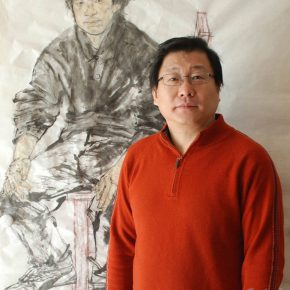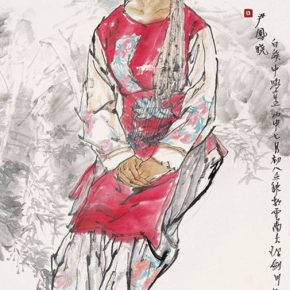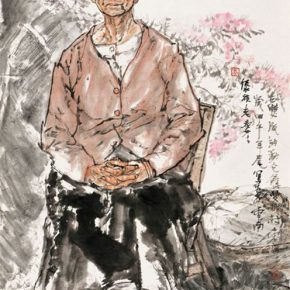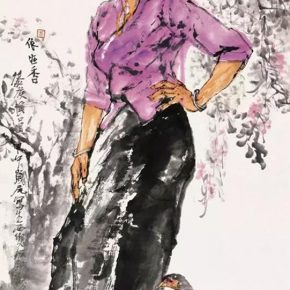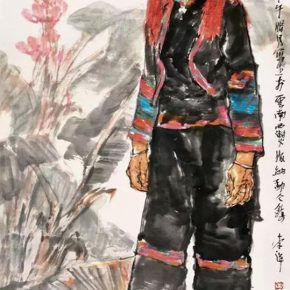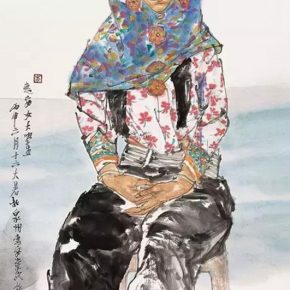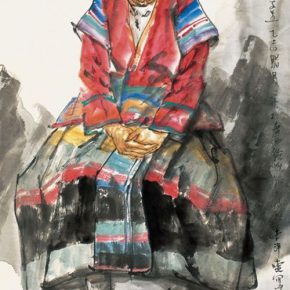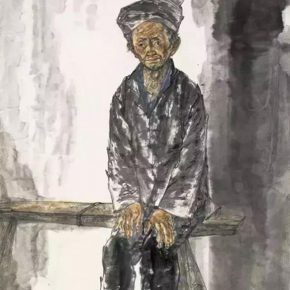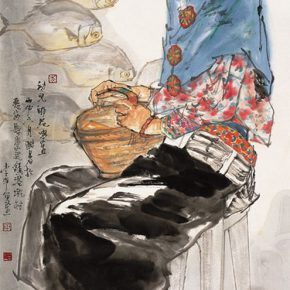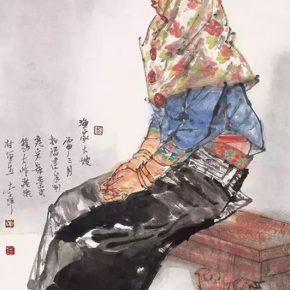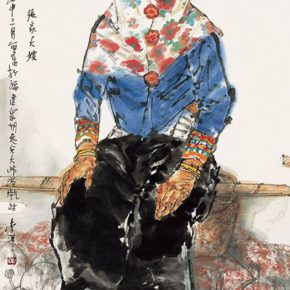
The “Sketch” and “artistic creation” are ordinary practices in painting, but there is a difference in the college teaching system. Sketching as a training means, to cultivate students’ ability in shaping, for the study; while the creation is the expression of artistic concept, for the creation, but both are difficult to combine and transform. Prof. Li Yang, Deputy Dean of the School of Chinese Painting, CAFA, has been in charge of the teaching and he has proposed an artistic idea of the “sketch as a work” for the status quo, and it applied to his own creative practice and teaching of the class, which has gained good results. On September 10, 2017, “The Sketch as a Work – Li Yang Exhibition of work” was unveiled in the Art Museum of the School of Fine Arts at the Minzu University of China and displays a group of works of figures under the guidance of the idea of “the sketch as a work”. During the exhibition, Li Yang offered a special interview to CAFA ART INFO, to explain the background, connotations and practical experiences of this idea in detail.
Date: September 12, 2017
Location: School of Chinese Painting, CAFA
Interviewer and copywriter: Zhang Wenzhi (hereinafter referred to as CAFA ART INFO)
Interviewee: Li Yang
Translated by Chen Peihua and edited by Sue/CAFA ART INFO
CAFA ART INFO: This exhibition is entitled “The Sketch as a Work”, which has been your idea of teaching for a long time, how can we understand it?Li Yang: The “Sketch” is usually a very important course in the art academy, and “as a work” is taken as a standard to grasp sketching, to finish a painting to make it a complete work. In the past, the training of sketching was a simple process of training of the basic skills. I have added many creative contents to the teaching, so that the students began to study creation when they have a training in the basic skills, thus making a seemingly simple training of basic skills rich, for example, the choice of images of characters, when I study a model, it is necessary to be clear on thoughts, spirit and connotation, while considering the posture, combination of the characters, the relationship between the character and things, the relationship between the character and the background, the relationship between the character and props. Eventually, the sketch is finished as a complete screen, appearing like a work. It is basically the content of the “sketch as a work”, and also the academic experience accumulated through teaching over the years, which is also my academic point of view.
I have written an article on this subject, published in the “Fine Arts” magazine in 2009, and then it was expanded and extended to include many contents. This exhibition actually presents the works created during my teaching, with my academic proposition, and it only 60 were selected from hundreds of outdoor sketches which were created over the last 10 years, including sketching creations finished during the periods of guiding students to sketch in Yunnan, Guizhou, Guangxi, Fujian, Heilongjiang, Gansu and other places, and this batch of works reflect my academic thinking of the “sketch as a work”.
CAFA ART INFO: When you just explained this concept, you simply mentioned the development of research and the creative practice of this idea since 2009, could you research it from a historical perspective?Li Yang: The theory of the “sketch as a work” is actually built on the deep tradition of teaching of Chinese painting and academic accumulation. For example, in Mr. Xu Beihong’s painting “Portrait of Tagore”, the poet’s spiritual temperament was vividly reflected in the screen. Another example is Mr. Jiang Zhaohe’s “Refugees Figure”, where he drew nearly a hundred people, including refugees, ordinary people, poets, cultural people, based on prototypes and this work was finished by sketching in the face of models, to finish the work that relies on the profound skills of shaping and creative Chinese ink painting.
What do I want to change with this teaching idea of the “sketch as a work”? In fact, it attempts to deal with the problem of the teaching of sketching as disjointed with the teaching of creation that has appeared in teaching for a long time. My idea of the “sketch as a work” is trying to build a bridge between sketching and creating, to communicate the training of basic skills with the creation, actually solving a problem in teaching.
CAFA ART INFO: Seen from the perspective of art history, although it never mentioned the concept of “sketch creation”, some theories of painting were also involved, for example, we would like to talk about the theory of “drawing the true”, and “preparing a draft by collecting varieties of information” proposed by Shi Tao. What is the difference between the “creation of a sketch” and the so-called relationship between the painting and object?Li Yang: Viewing both the painting theory and works, we can find that early on Chinese painting has actually emphasized focusing on life. The “Sketch” was not clearly claimed in ancient China, and it was derived from the absorption of training methods of Western academies of fine arts. When the Chinese painting entered the college teaching system in the 1920s and 1930s, it began to introduce this means of Western teaching, through drawing, quick sketching, color, sketching, perspective and anatomy to train the artists’ ability in shaping. The students who majored in figure painting are grasped the skills of shaping through some approaches from the West and then through the copy of Chinese painting created a law, together when creating Chinese figure paintings.
CAFA ART INFO: In the college teaching system, what is the biggest difference between the sketching of Chinese painting and the sketching of other disciplines?Li Yang: Chinese painting has been pursuing the principle of shaping with a target that is different from the West, although we borrow the means of shaping the West to train students, we are very clear that the core of shaping and aesthetics is the spirit for freehand teaching of Chinese painting. Through brush and ink we can express the painters’ feelings of nature and objects, to become a language of artistic expression, while Chinese ink is also an unique cultural phenomenon in Chinese culture. The shaping means of Chinese painting is also a form of intentional shaping, rather than imitating the object. It emphasizes the artist’s understanding of the object, emphasizing the artist’s ontological consciousness, as well as their worldview and values. So that, I require students to make a special creation when they draw the same person, for everyone’s feeling is different. Chinese painting emphasizes the painter himself.
CAFA ART INFO: You are studying the “sketch as a work” in the field of Chinese painting and directing the teaching, could you tell us what influence or meaning do you think the concept has on the creation of Chinese painting in the future?Li Yang: I have thought about this many years ago as to whether Chinese painting could form an independent and complete work through the sketch or not. By describing the object in front of me, through my artistic mind and thoughts to change it, to make a simple sketch lively, to be thoughtful, spiritual and meaningful, while the screen is processed to be rich and complete with a background & props, and an objective space, through the processing it is possible to produce a very smart and fresh scene, which is different from our past training in the basic skills of sketching. I have studied and practiced these works including the works of the exhibition, over the years, actually to present a complete work, which was finished with real people, by on-site sketching and created when I faced the models.


